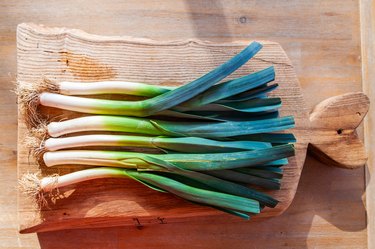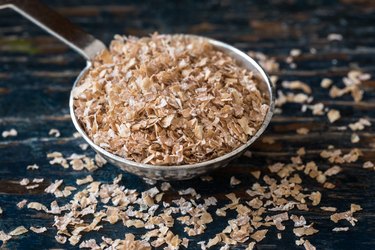There's plenty of talk about fiber but inulin, a type of soluble fiber that comes from plants, sort of falls in its shadow.
Inulin acts as a prebiotic, the naturally occurring, non-digestible parts of food that feed the healthy bacteria that live in your gut. Although inulin is added to some processed foods, you can also get a good amount from certain whole plant foods.
Video of the Day
Video of the Day
While there's no official recommended daily value for inulin fiber, eating inulin-rich foods may help your digestive health as well as appetite control. For example, a small June 2019 study in the American Journal of Clinical Nutrition found that eating more inulin led to people feeling fuller and less tempted to eat sweet and salty foods.
Plus, there are a number of health benefits associated with prebiotics such as inulin, including balanced gut microbiota, more mineral absorption and a lower risk of constipation and irritable bowel diseases, per an October 2017 study in Critical Reviews in Food Science and Nutrition.
Tip
The Academy of Nutrition and Dietetics recommends eating around 14 grams of fiber (of all types) per 1,000 calories that you eat each day. So if you eat 2,000 calories a day, aim for 28 grams of fiber.
There’s no specific recommendation for the amount of inulin to eat daily.
Get more inulin and reap the benefits of this fiber by adding these foods to your diet. Here are the top inulin-rich foods per 100 grams (about 3.5 ounces), according to the International Probiotics Association.
1. Chicory Root: 41.6 grams

The food with the most inulin is chicory root, which is often used as livestock feed, but can also be part of a healthy diet for us. The leaves and flowers can be used fresh in salads and the root itself can be used as a coffee substitute, per a December 2017 report in The Scientific World Journal. The roots are naturally bitter, but cooking or soaking them in water can help soften the flavor.
2. Jerusalem Artichokes: 18 grams
Despite their name, Jerusalem artichokes (aka sunchokes) are tubers and don't look anything like the similarly named globe artichoke. Sunchokes have a crisp texture and nutty flavor and can be used raw in salads, salsas, chutneys and cooked alongside grilled poultry or fish, According to the Center for Urban Education About Sustainable Agriculture.
On top of their inulin content, sunchokes provide nearly one-fifth of your daily iron needs, as well as a good amount of copper and vitamin B1, according to the USDA.
3. Dandelion Greens: 13.5 grams
Dandelions might be a pesky weed in your garden, but they're a surprising source of nutrition. In addition to inulin, dandelion greens are a great source of vitamins A, C and K, as well as folate, calcium and potassium, according to the Cleveland Clinic.
Although you can eat these greens raw, they're slightly bitter. To fix that, soak the dandelion greens in cold, salted water for up to 15 minutes, then boil them until tender.
4. Garlic: 12.5 grams
Admittedly, you're probably not eating 3.5 ounces of garlic in one sitting, but this allium has a good amount of inulin — and if you're a garlic lover, it adds up over time. Beyond inulin, garlic has a bit of vitamin C and B6, as well as the minerals manganese and selenium, per the USDA.
5. Leeks: 6.5 grams

Onions' cousin, leeks, has a sweeter and milder flavor, according to the Produce for Better Health Foundation. Leeks are a good source of inulin, but they're also high in vitamin K and vitamins B6 and C, as well as copper, iron and manganese.
Leeks are referred to as "dirty" vegetables because of the way they grow in the soil — so they need a good cleaning before eating by removing the roots and outer leaves, cutting the stalk in half lengthwise and running water through the vegetables' layers, per Food and Nutrition magazine, a publication of the Academy of Nutrition and Dietetics.
6. Asparagus: 2.5 grams
Although it might not be as high in inulin as other vegetables, asparagus has a well-rounded nutritional profile that makes it a good choice for one of your daily vegetable servings.
Asparagus is one of the world's top 20 vegetable crops, and it comes in green, purple and white hues, per January 2020 research in Metabolites. It offers plenty of nutrients, including vitamins B1, B2, B3, K and E, as well as the minerals selenium, iron, calcium, copper, zinc, magnesium, potassium and phosphorus.
7. Wheat Bran: 2.5 grams

Wheat bran is the outer layer of the whole grain, and it's rich in B vitamins, iron, copper, zinc, magnesium, phytochemicals and antioxidants, according to the Harvard T.H. Chan School of Public Health.
Wheat bran is available as a cereal, but you can also crush them up and add them to meatballs to help keep them moist, per the University of Nebraska, Lincoln.
8. Bananas: 0.5 grams
Bananas are a source of inulin, though they don't rank as high as other plant foods. When you eat a banana, you'll also get a good amount of vitamin C and potassium, per the Produce for Better Health Foundation.
A Note on Inulin Side Effects
If you increase your inulin intake drastically and quickly, you might experience some less-than-ideal gastrointestinal side effects — namely, stomach pain, bloating and gas, according to the Linus Pauling Institute.
Try to add inulin foods slowly into your diet and drink plenty of water along with them. The benefits of inulin foods significantly outweigh any side effects.
- American Journal of Clinical Nutrition: “Effects of a Diet Based on Inulin-Rich Vegetables on Gut Health and Nutritional Behavior in Healthy Humans”
- Critical Reviews in Food Science and Nutrition: “Functional and Therapeutic Potential of Inulin: A Comprehensive Review”
- Academy of Nutrition and Dietetics: “Easy Ways to Boost Fiber in Your Daily Diet”
- International Probiotics Association: “A New Look at Prebiotic Fibers”
- The Scientific World Journal: “Chemical Composition and Nutritive Benefits of Chicory (Cichorium intybus) as an Ideal Complementary and/or Alternative Livestock Feed Supplement”
- Center for Urban Education About Sustainable Agriculture: “Sunchokes”
- Cleveland Clinic: “Can You Eat Dandelions?”
- VCU Health: “4 Health Benefits of Garlic”
- Produce for Better Health Foundation: “Leek”
- Food and Nutrition Magazine: “Leeks: This Onion Cousin Delivers Unique Textures and Delicate Flavors”
- Metabolites: "Green and White Asparagus (Asparagus officinalis): A Source of Developmental, Chemical and Urinary Intrigue"
- Harvard T.H. Chan School of Public Health: "Whole Grains"
- University of Nebraska, Lincoln, Extension: "Bran Flakes"
- USDA: "Jerusalem-Artichokes Raw"
- Produce for Better Health Foundation: "Banana"
- Linus Pauling Institute: "Fiber"